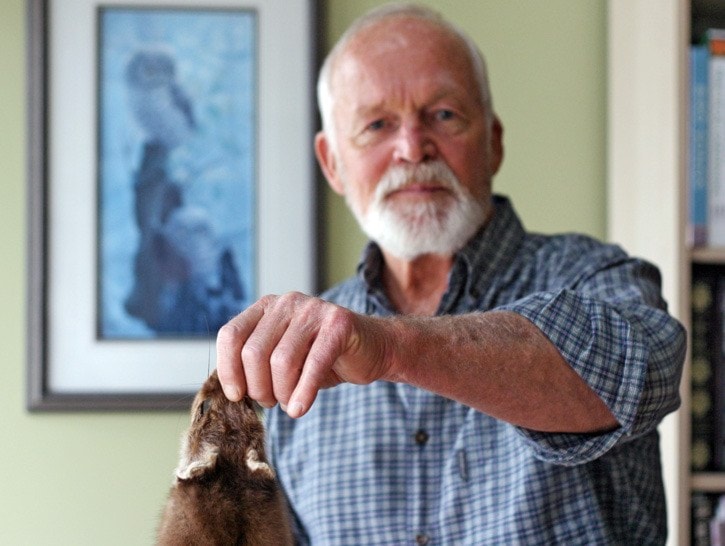Looking out his window, trapper Larry Austin trains his eye on a spot where the trees dip some six or eight kilometres across the Bulkley Valley."Do you see the conifer forest, and the deciduous with it? And where the creek comes down?""That's typical marten habitat," he says.Marten are a "bread and butter" catch for B.C.'s 2500 fur trappers, said Austin.As a licensed trapper himself, Austin has not only been trained how to catch and skin the weasel-like creatures—he also has to track their numbers to see that they keep a healthy population."Habitat's very important for them," he said. "I leave them the high ranges to breed and to grow up."Prized for their light yellow to sable-brown fur, wild marten are caught by trappers from Europe to Russia and Japan. Marten measure up to 25 inches long, about a third of which is tail, and they tend to snack on mice, voles, and squirrels.Austin sets his traps along the creek beds where those rodents gather, or by piles of logging debris."If you can find a logging patch like that, it's a condominium for mice," he said, laughing.Austin takes just 15 marten a year—a quota he set himself after surveying the numbers of marten on his trapline.Pulling out a trapper's map, Austin points out his trapline and the habitat areas feeding into it. Shaped like a westward-pointing arrow, its tip covers half of Morice Mountain and the south shoulder of the Telkwa range.One of its tail ends right in downtown Houston on the edge of Buck Creek."It's only a 100 square miles," he explained. Many B.C. traplines are twice that size.But tracking the marten, wolf, lynx, wolverines and other wild animals who live in that 100 square miles of backcountry is plenty to keep Austin busy in middle of winter."You know, we should be thinking of flying south—but I can't," he said. "Every November 1 I get so excited."Austin bought his trapline in 1994, when he was quite surprised to see an ad for it in the classified pages of the Houston Today."This was the best of two worlds," Austin said, explaining that he had always wanted to go into wildlife management, but wasn't sold on the idea of packing a sidearm and policing people."The old conservationist used to be a romantic-type person," he said. "But today he's like a cop."Still, Austin found a way into the backcountry. He retired in 1998 after thirty years of running through the bush as a forestry technician.When he first started, Austin remembers a forestry prof who told him, "'You know, we've taught you as much as we can. But that's just the ABC's—now you go out and learn the rest of it in the woods.'"By trapping, Austin found a way to keep up that hands-on learning in retirement."You know, we should be thinking of flying south—but I can't," he said. "Every November first I get so excited."Although trapping season opens in November, Austin likes to wait until early December when temperatures drop and martens prime up their fur.His patience has paid off—a few years ago, Austin was awarded a prize for top-quality furs from the North American Fur Auction Association (NAFAA).Most trappers sell their furs through association like NAFAA, but trapping is no longer the gold mine it was back in the days of Simon Fraser."There's very few people who can make a living off it," he said."It's a love of labour," he joked, "Or a labour of love."That's not to say that there isn't money in fur.Some time ago, Austin visited Holt Renfew—a three-storey, high-fashion fortress in downtown Vancouver.Austin saw a "sable," or marten-fur coat on the wall and walked up to check the price tag."So I grabbed it—bling, bling, bling!—and the alarm went off," he said."'I'm a trapper, I just want to look at it,'" he told the sales clerk, who seemed equally alarmed. The price tag? $23,500.As well as outrageously priced coats, Vancouver is one of the places where you can find a lot of outrage against the fur trapping industry.But trapping has come a long way from the giant, claw-tooth bear traps that people see in Bugs Bunny cartoons."Those are horrible," Austin said.Austin mostly uses "conibear" traps, named after Canadian trapper Frank Conibear, who designed them in 1957 as a way to kill animals more quickly and humanely.Unlike leg-grabbing traps, conibears snap quickly around an animal's neck and chest, ensuring a 100 per cent kill rate.As well as fur, trappers catch animals like marten and beaver for the oil in their large oil glands."I have to be really, really careful not to burst that," Austin said, adding that the concentrated oils have an overpowering smell.But if collected properly, those oils go amazing places."They even put it in perfume—the best perfumes, like Channel No. 5," he said with a smile."Don't tell the ladies that."
